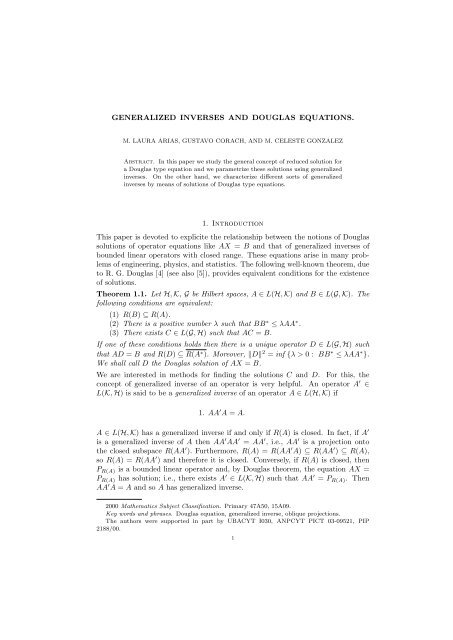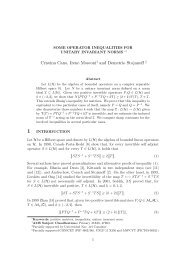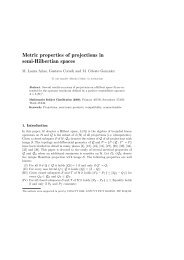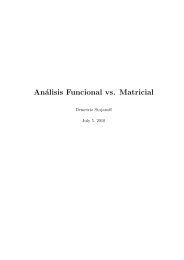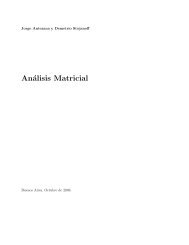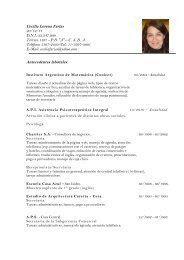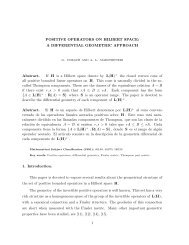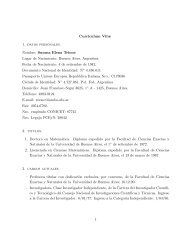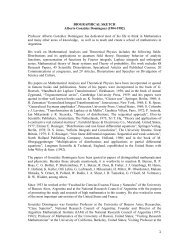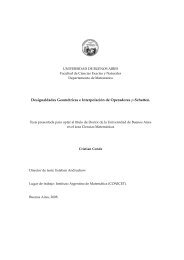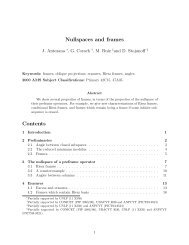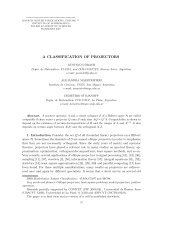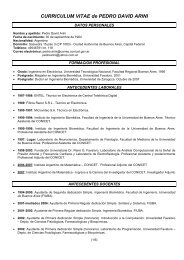GENERALIZED INVERSES AND DOUGLAS ... - IAM - Conicet
GENERALIZED INVERSES AND DOUGLAS ... - IAM - Conicet
GENERALIZED INVERSES AND DOUGLAS ... - IAM - Conicet
You also want an ePaper? Increase the reach of your titles
YUMPU automatically turns print PDFs into web optimized ePapers that Google loves.
<strong>GENERALIZED</strong> <strong>INVERSES</strong> <strong>AND</strong> <strong>DOUGLAS</strong> EQUATIONS.M. LAURA ARIAS, GUSTAVO CORACH, <strong>AND</strong> M. CELESTE GONZALEZAbstract. In this paper we study the general concept of reduced solution fora Douglas type equation and we parametrize these solutions using generalizedinverses. On the other hand, we characterize different sorts of generalizedinverses by means of solutions of Douglas type equations.1. IntroductionThis paper is devoted to explicite the relationship between the notions of Douglassolutions of operator equations like AX = B and that of generalized inverses ofbounded linear operators with closed range. These equations arise in many problemsof engineering, physics, and statistics. The following well-known theorem, dueto R. G. Douglas [4] (see also [5]), provides equivalent conditions for the existenceof solutions.Theorem 1.1. Let H, K, G be Hilbert spaces, A ∈ L(H, K) and B ∈ L(G, K). Thefollowing conditions are equivalent:(1) R(B) ⊆ R(A).(2) There is a positive number λ such that BB ∗ ≤ λAA ∗ .(3) There exists C ∈ L(G, H) such that AC = B.If one of these conditions holds then there is a unique operator D ∈ L(G, H) suchthat AD = B and R(D) ⊆ R(A ∗ ). Moreover, ‖D‖ 2 = inf {λ > 0 : BB ∗ ≤ λAA ∗ }.We shall call D the Douglas solution of AX = B.We are interested in methods for finding the solutions C and D. For this, theconcept of generalized inverse of an operator is very helpful. An operator A ′ ∈L(K, H) is said to be a generalized inverse of an operator A ∈ L(H, K) if1. AA ′ A = A.A ∈ L(H, K) has a generalized inverse if and only if R(A) is closed. In fact, if A ′is a generalized inverse of A then AA ′ AA ′ = AA ′ , i.e., AA ′ is a projection ontothe closed subspace R(AA ′ ). Furthermore, R(A) = R(AA ′ A) ⊆ R(AA ′ ) ⊆ R(A),so R(A) = R(AA ′ ) and therefore it is closed. Conversely, if R(A) is closed, thenP R(A) is a bounded linear operator and, by Douglas theorem, the equation AX =P R(A) has solution; i.e., there exists A ′ ∈ L(K, H) such that AA ′ = P R(A) . ThenAA ′ A = A and so A has generalized inverse.2000 Mathematics Subject Classification. Primary 47A50, 15A09.Key words and phrases. Douglas equation, generalized inverse, oblique projections.The authors were supported in part by UBACYT I030, ANPCYT PICT 03-09521, PIP2188/00.1
2 M. LAURA ARIAS, GUSTAVO CORACH, <strong>AND</strong> M. CELESTE GONZALEZAs a consequence, if R(B) ⊆ R(A) and R(A) is closed then {A ′ B : AA ′ A = A} isa set of solutions of the equation AX = B. In fact, A(A ′ B) = QB = B, becauseQ = AA ′ is a projection onto R(A).If A ∈ L(H, K) has closed range then it has a unique generalized inverse A ′ inL(K, H) which also verifies:2. A ′ AA ′ = A ′3. (AA ′ ) ∗ = AA ′4. (A ′ A) ∗ = A ′ A.This distinguished generalized inverse is called the Moore Penrose (generalized)inverse of A and is denoted by A † . This result is due to E. H. Moore [9] and R.Penrose [11], [12]. For excellent expositions of these matters the reader is referredto the books [10] and [1] among many other sources. If R(B) ⊆ R(A) and R(A)is closed then A † B is the Douglas solution of AX = B. This assertion is thestarting point of this paper. We denote A[i], A[i, j], A[i, j, k], A[i, j, k, l] the setsof operators X in L(K, H) that satisfy equations {i}, {i, j}, {i, j, k} and {i, j, k, l}respectively, for i, j, k, l = 1, 2, 3, 4. Then, by the result of Moore and Penrose,A[1, 2, 3, 4] = {A † }. As a by product of our approach we show a very short proofof the existence and uniqueness of the Moore-Penrose inverse of a matrix A.In section 2 we introduce a notion of reduced solution which is a generalization ofthe concept of Douglas solution. We characterize the set of these solutions and wegive a parametrization of this set using Douglas solutions.In section 3 we establish the relationship between the sets A[1], A[1, i], A[1, i, j]and A[1, i, j, k] and different Douglas type equations.Finally, we collect in section 4 some results on continuity of the mapping (A, B) →Douglas solution of AX = B.We conclude this introduction by fixing notation and terminology. ThroughoutH, K, G denote complex Hilbert spaces, L(H, K) the space of bounded linear operatorsfrom H to K, CR(H, K) the subset of L(H, K) of all operators with closedrange. The range of an operator A is denoted by R(A) and its nullspace by N(A).We denote by Q the set of projections of L(H), i.e., Q = { Q ∈ L(H) : Q 2 = Q } .Fixed a closed subspace S of H, Q S denotes the set of projections with range Sand P S denotes the orthogonal projection of H onto S. The direct sum betweentwo closed subspaces S, T is denoted S +T . . Observe that the existence of a decompositionH = S + . T is equivalent to the existence of a unique Q ∈ Q S such thatN(Q) = T , Q is usually denoted by Q S//T .The next propositions will be used in this paper. See [7] and [3], respectively, forthe proofs .Proposition 1.2. If S and T are closed subspace of H and S + T is closed, thenIn particular, S ⊥ + T ⊥ is closed.S ⊥ + T ⊥ is closed.(S ∩ T ) ⊥ = S ⊥ + T ⊥ .Consequently, S + T is closed if and only if
4 M. LAURA ARIAS, GUSTAVO CORACH, <strong>AND</strong> M. CELESTE GONZALEZCorollary 2.2. If A ∈ CR(H, K), B ∈ L(G, K) and R(B) ⊆ R(A) then A † B is theDouglas solution of AX = B.Remark 2.3. If R(A) is not closed, then A † is well defined unbounded operatorand the result above is still valid. We leave the details for the reader.Corollary 2.4. Under the same hypotheses of the Theorem 2.1, every solution ˜Xof AX = B can be written as˜X = X 0 + X M ,where X 0 is any solution of the homogeneous equation AX = 0 and X M is thereduced solution for some M as before.The next result shows the relationship between different reduced solutions by meansof certain oblique projections.Theorem 2.5. Let A ∈ CR(H, K), B ∈ L(G, K) be such that R(B) ⊆ R(A) and letM be a closed subspace of H such that M . + N(A) = H. Then X M is the reducedsolution for M of the equation AX = B if and only if X M = Q M//N(A) X R(A∗ ).Proof. Let X M be the reduced solution for M of the equation AX = B. Then, asit was shown in the proof of Theorem 2.1, there exists Q ′ ∈ Q R(A) such that A ′ =Q M//N(A) A † Q ′ ∈ A[1, 2] and X M = A ′ B. Thus, X M = A ′ B = Q M//N(A) A † Q ′ B =Q M//N(A) A † B = Q M//N(A) X R(A∗ ). The third equality holds because R(B) ⊆R(Q ′ ).Conversely, let ˆX = Q M//N(A) X R(A∗ ). Since A(X R(A∗ ) - ˆX) = A(I - Q M//N(A) )X R(A ∗ ) = AQ N(A)//M X R(A ∗ ) = 0 then A ˆX = B and so ˆX = X M .□3. Generalized inverses and Douglas equation.In this section we study the equations AX = Q, where Q is a projection onto therange of A and the relationship between their solutions with the sets A[1], A[1, i],A[1, i, j] and A[1, i, j, k]. Part of the information contained in the following resultcan be found disseminated in the literature. The reader is referred to the book byBen-Israel and Greville [1] (see in particular, chapter 1 and 2).Theorem 3.1. Given A ∈ CR(H, K) it holds that:(i) A[1] = {X ∈ L(K, H) : AX = Q for some Q ∈ Q R(A) }.(ii) A[1, 2] = {X ∈ L(K, H) : AX = Q ∈ Q R(A) and N(X) = N(Q)}.(iii) A[1, 3] = {X ∈ L(K, H) : AX = P R(A) }.(iv) A[1, 4] = {X ∈ L(K, H) : XA = P R(A ∗ )}.(v) A[1, 2, 3] = {X ∈ L(K, H) : AX = P R(A) and N(X) = R(A) ⊥ }.(vi) A[1, 2, 4] = {X ∈ L(K, H) : XA = P R(A ∗ ) and R(X) ⊆ R(A ∗ )}.(vii) A[1, 3, 4] = {X ∈ L(K, H) : AX = P R(A) and XA = P R(A∗ )}.(viii) A[1, 2, 3, 4] = {Douglas solution of AX = P R(A) }.Proof.(i) Let X ∈ A[1], i.e., X verifies that AXA = A. Hence, AXAX=AX andR(A) ⊆ R(AX) ⊆ R(A). Then AX ∈ Q R(A) . Conversely, let X such thatAX = Q for some Q ∈ Q R(A) then AXA = QA = A.(ii) Consider X ∈ A[1, 2]. Then, by (i), AX = Q ∈ Q R(A) and so N(X) ⊆N(Q). On the other hand, since X = XAX = XQ, N(Q) ⊆ N(X). Thus,N(X) = N(Q). On the contrary, choose X ∈ L(K, H) such that AX = Q ∈Q R(A) and N(X) = N(Q) then, by (i), X ∈ A[1]. In order to prove that
6 M. LAURA ARIAS, GUSTAVO CORACH, <strong>AND</strong> M. CELESTE GONZALEZdecompositionsA =( a 00 0observe that a : R(A ∗ ) ( → R(A) ) is an isomorphism. Now, ( let x ∈)L(R(A ∗ ), N(A)),x ≠ 0. Define ˜Q 1 01 0=∈ L(H) and Q =∈ L(K). Then( )x 00 0a ˜QA † −10Q =xa −1 ∈ A[1, 2] and R(0˜QA † Q) = R(A ∗ ) ⊕ R(x) ⊈ R(A ∗ ). Therefore˜QA † Q /∈ X R(A∗ ).);4. About the continuity of reduced solutions.It is well known that the mapping A → A † is not continuous, in general. See [8] forseveral results in these matters. We show here how the relationship between Douglassolution and generalized inverses gives some continuity results for the mapping(A, B) → Douglas solution of AX = B.In this section, for sake of simplicity we only consider operators H → H. ForT ∈ L(H) the reduced minimum modulus of T is γ(T ) = inf{‖T x‖ : x ∈ N(T ) ⊥ and‖x‖ = 1}. It is well known that γ(T ) > 0 if and only if R(T ) is closed.For each positive integer k, let(4.1) R k = R k (H) = {T ∈ L(H) : γ(T ) ≥ 1/k}.These sets verify:(1) CR(H) = ∪ R k .k∈N(2) R k R k ′ if k ′ > k.(3) T ∈ R k if and only if T ∗ ∈ R k .(4) For every k ∈ N, R k is closed.Given A ∈ CR(H) we define E A = {B ∈ L(H) : R(B) ⊆ R(A)}. Similarly, givenB ∈ L(H) we define Ek B = {A ∈ R k : R(B) ⊆ R(A)}. Consider the mappingsφ A : E A → L(H) and φ B k : E k B → L(H) defined by φ A(B) = φ B k(A) = Douglassolution of the equation AX = B. Next, we study the continuity of these mappings.Proposition 4.1. φ A is continuous.Proof. Let B, ˜B ∈ E A . Then φ A (B) = A † B and φ A ( ˜B) = A † ˜B. Let ɛ > 0, then‖φ A (B) − φ A ( ˜B)‖ = ‖A † B − A † ˜B‖ = ‖A † (B − ˜B)‖ ≤ ‖A † ‖‖B − ˜B‖ < ɛif ‖B − ˜B‖ < δ 0 and A, à ∈ E B k . Then φB k (A) = A† B and φ B k (Ã) = Æ B. Now, bylemma 4.2, it holds‖φ B k (A) − φ B k (Ã)‖ = ‖A† B − Æ B‖ = ‖(A † − Æ )B‖≤‖A † − Æ ‖‖B‖ ≤ 3k 2 ‖A − Ã‖‖B‖ < ɛ□
if ‖A − Ã‖ < δ


